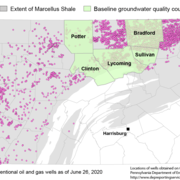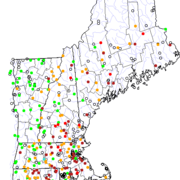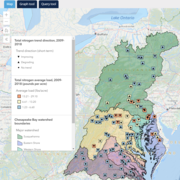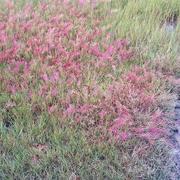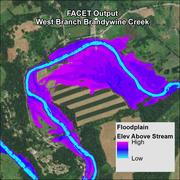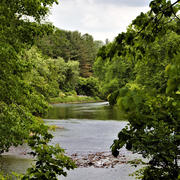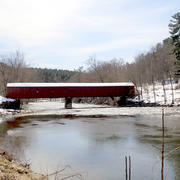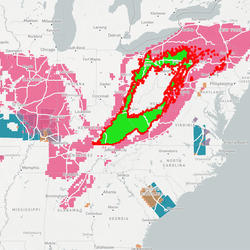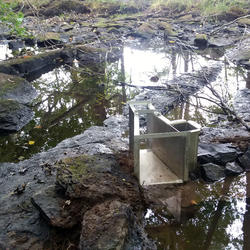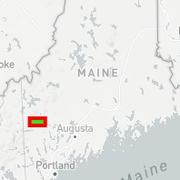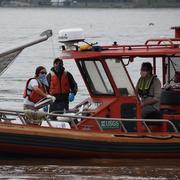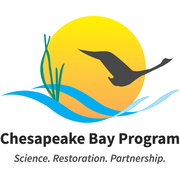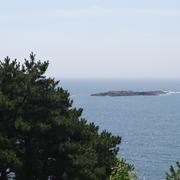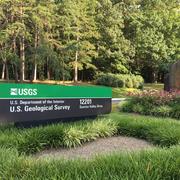Unified Interior Regions
Region 1: North Atlantic-Appalachian
Our Science Centers
The NAA Region has 15 Science Centers spanning 14 NE States and Washington, DC. The Centers conduct interdisciplinary biologic, geologic, hydrologic, and energy monitoring and research addressing natural resource issues facing our nation.
Learn MoreMarch Photo Contest
Check out the winning photographs in the March 2020 Photo Contest! Categories include People, USGS at Work, Where We Work, and Honorable Mention
See PhotosRegions L2 Landing Page Tabs
We conduct impartial, multi- and interdisciplinary research and monitoring on a large range of natural-resource issues that impact the quality of life of citizens and wildlife throughout the New England and Mid-Atlantic states of Connecticut, Delaware, Kentucky, Maine, Maryland, Massachusetts, New Hampshire, New Jersey, New York, Pennsylvania, Rhode Island, Vermont, Virginia, and West Virginia.
Region 1: North Atlantic-Appalachian PFAS Capability Team
Per- and polyfluoroalkyl substances (PFAS) are a group of anthropogenic emerging contaminants. Some PFAS have been voluntarily phased out, as exposure has been linked to adverse human health effects.
New England Drought, 2020
Below average and infrequent rainfall from May through September 2020 led to an extreme hydrologic drought across much of New England, with some areas experiencing a flash (quick-onset) drought.
Functional and Molecular Bioassay Laboratory
The Functional and Molecular Bioassay Laboratory applies and modifies microbial and eukaryotic reporter bioassays to detect the presence of bioactive chemicals from environmental water samples. These analyses compliment analytical chemistry and biological datasets.
Monitoring Merrimack River Mainstem and Tidal Reaches in Massachusetts to Evaluate Water Quality Conditions, May to September 2020
The Merrimack River watershed, the 4th largest watershed in New England (Massachusetts Executive Office of Environmental Affairs, 2001), has seen substantial growth and development in recent years.
Groundwater Quality of Domestic Supply Wells in Pennsylvania
Most rural residents in Pennsylvania use groundwater from domestic supply wells for drinking, cleaning and other purposes. Some groundwater samples have been analyzed for private purposes, but those results generally are not readily available to the public. Many of the publicly available water-quality samples from rural areas were collected more than 30 years ago. Quality-assured groundwater...
Shale Gas and Water Resources in Pennsylvania
The Pennsylvania Water Science Center and other USGS scientists are studying water availability, use, quality, and ecology associated with development of shale-gas energy resources in Pennsylvania.
Latest Report: Potter County 'Baseline' Groundwater Quality (see Publications)
Samples Repository
Since 2002, the Woods Hole Coastal and Marine Science Center’s Samples Repository (WHCMSC) has been supporting research by providing secure storage for geological, biological, and geochemical samples; maintaining organization and an active inventory of these sample collections; as well as by providing access to these collections for study and reuse.
Streamflow Estimation from Advanced Imaging (LSPIV) in Pennsylvania
Pennsylvania Water Science Center and the Next Generation Water Observing Systems (NGWOS) Program are implementing new technologies for streamflow estimation at sites in Pennsylvania where conventional measurement techniques are inadequate.
Delaware River Basin
In Pennsylvania, the USGS's water-resources roots date back to the late 1800's, with the initiation of streamflow gaging on the Delaware and Susquehanna Rivers and assessments of groundwater resources near Philadelphia. The USGS Pennsylvania Water Science Center continues to provide scientific information about the water resources of the Delaware River Basin, in cooperation with regional and...
MD-DE-DC WSC Water Use & Water Supply Capabilities
In Maryland, public supply water is delivered to users for domestic, commercial, and industrial purposes. Most is used for public services, such as public pools, parks, firefighting, water and wastewater treatment, and municipal buildings, and some is unaccounted for because of leaks, flushing, tower maintenance, and other system losses. 5.7 million Marylanders get their water from the public...
MD-DE-DC WSC Modeling Capabilities
USGS models are widely used to predict responses of hydrologic systems to changing stresses, such as increases in precipitation or ground-water pumping rates, as well as to predict the fate and movement of solutes and contaminants in water.
The USGS is at the forefront of devising new techniques and computer software to solve practical problems in the study of water resources....
Collection, analysis, and age-dating of sediment cores from a salt marsh platform and ponds, Rowley, Massachusetts, 2014-15
Sediment cores were collected from three sites within the Plum Island Ecosystems Long-Term Ecological Research (PIE-LTER) domain in Massachusetts to obtain estimates of long-term marsh decomposition and evaluate shifts in the composition and reactivity of sediment organic carbon in disturbed marsh environments.
Sea-floor sediment samples, seabed imagery, and CTD instrument data collected on Stellwagen Bank in July and August, 2019, U.S. Geological Survey Field Activity 2019-008-FA
This cruise was conducted in collaboration with the Stellwagen Bank National Marine Sanctuary, and the data collected will aid research on the ecology of fish and invertebrate species that inhabit the region.
New England Below Normal 28-day average streamflow compared to historical streamflow for the day of year
Below Normal 28-day average streamflow compared to historical streamflow for the day of year
Continuous Seismic Profiling (CSP) at Callahan Mine Site: May 2017 to July 2018
In May 2017 and July 2018, continuous seismic profiling (CSP) surveys were collected in Goose Pond at the Callahan Mine site. The chirp frequency CSP tool was used in the deep water. A tuned transducer (dual-echo sounder) was used in the shallow water, and the data are served separately but within this data release (See CSP-DSO). CSP methods use an acoustic sound source that trave
Loads and trends in the Chesapeake Bay nontidal monitoring network: results through Water Year 2018
The U.S. Geological Survey (USGS) has developed the nontidal network mapper to share the short-term (2009-2018) water-year nutrient and suspended-sediment load and trend results for the Chesapeake Bay Program’s (CBP) non-tidal network (NTN). The mapper provides the primary findings for nitrogen, phosphorus and suspended-sediment trends, and gives the user tools to further examine the results...
Pesticide Toxicity Index (PTI) and maximum Toxic Unit (TUmax) scores and information for fish, cladocerans, and benthic invertebrates from water samples collected at National Water Quality Network sites during Water Years 2013-2017
During 2013-2017, the U.S. Geological Survey, National Water-Quality Assessment (NAWQA) Project, collected water samples year-round from the National Water Quality Network – Rivers and Streams (NWQN) and reported on 221 pesticides at 72 sites across the US in agricultural, developed, and mixed land use watersheds. Pesticide Toxicity Index (PTI) scores, a screening-
Chemical and physical data for sediment source fingerprinting of suspended and bottom sediment in Black Creek, Indiana, tributary to the Maumee River and western Lake Erie - Fluvial-target samples
This data release includes physical and chemical data for samples from fluvial targets (streambed and suspended sediment) from three sampling sites in the Black Creek basin, Indiana. Data include total nitrogen and carbon concentrations, carbon species, total concentrations for 42 metals, and particle-size analysis. Fluvial-target samples include both soft, streambed sediment and
Chemical and physical data for sediment source fingerprinting of suspended and bottom sediment in Black Creek, Indiana, tributary to the Maumee River and western Lake Erie - Source samples
This data release includes physical and chemical data for samples from upland-source and streambank sampling sites in the Black Creek basin, Indiana. Data include total nitrogen and carbon concentrations, carbon species, total concentrations for 42 metals, and particle-size analysis. Source samples were identified as one of five land-use types: active cropland (corn, soybean, h
Data for multiple linear regression models for predicting microcystin concentration action-level exceedances in selected lakes in Ohio
Site-specific multiple linear regression models were developed for eight sites in Ohio—six in the Western Lake Erie Basin and two in northeast Ohio on inland reservoirs--to quickly predict action-level exceedances for a cyanotoxin, microcystin, in recreational and drinking waters used by the public. Real-time models include easily- or continuously-measured factors that do not require
Precipitation and Precipitation Chemistry in Robinson Forest, Breathitt County, Kentucky (1971-2018)
Robinson Forest, in eastern Kentucky, is a research forest owned and operated by the University of Kentucky (UK) since the 1920s. The UK Department of Forestry and Natural Resources began collecting precipitation and precipitation chemistry data in the forest starting with one weather station at the Robinson Forest Camp in 1971, and followed by several additional stations in the mid-199
Air temperature in Robinson Forest, Breathitt County, Kentucky (1971-2018)
Robinson Forest, in eastern Kentucky, is a research forest owned and operated by the University of Kentucky (UK) since the 1920s. The UK Department of Forestry and Natural Resources began collecting air temperature data at the Robinson Forest Camp in 1971. This digital dataset includes information about the weather station where these data were collected, and how these data were process
Chesapeake Bay River Input Monitoring Network 1985-2019: Annual loads
Nitrogen, phosphorus, and suspended-sediment loads, and changes in loads, in major rivers across the Chesapeake Bay watershed have been calculated using monitoring data from the Chesapeake Bay River Input Monitoring Network (RIM) stations for the period 1985 through 2019. Nutrient and suspended-sediment loads and changes in loads were determined by applying a weighted regression appro
The New England Water Science Center has collected, reviewed, and aggregated water-withdrawal data in each of the six States every 5 years since 1950. The most recent water-use compilation was completed in 2015, and its summary is presented in this geonarrative.
Coastal wetlands, and salt marshes specifically, are simultaneously geomorphic and biologic systems. They proliferate across a narrow range of elevation, water level, and salinity conditions. Salt marshes rely on their own growth and sediment input to maintain or increase their extent, whereas physical forces such as waves and sea-level rise tend to reduce it.
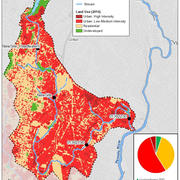
Third River - Lower Passaic River Basin 2020
Lower Passic River - Third River Basin 2020

Second and Third Rivers - Lower Passaic River Basin 2020
Lower Passaic River Basin 2020
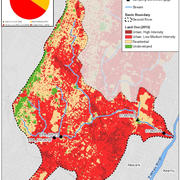
Second River - Lower Passaic River Basin 2020
Lower Passaic River - Second River Basin 2020
Domestic wells provide drinking water supply for approximately 40 million people in the United States. Knowing the location of these wells, and the populations they serve, is important for identifying heavily used aquifers, locations susceptible to contamination, and populations potentially impacted by poor-quality groundwater.
The New England WSC geonarrative explores the availability of water-quality data collected by the Cape Cod National Seashore and U.S. Geological Survey in support of the Herring River restoration project. It highlights the development of the monitoring program since the 1980s and the recent publication of Cape Cod National Seashore data in a U.S. Geological Survey data release.
Simulated 25-year mean annual potential recharge to groundwater for Maine, 1991 to 2015.
Calculated standard deviation on the median annual potential recharge to groundwater for Maine, 1991 to 2015.
Three Bays watershed area and locations of four sites for preliminary hydrogeologic site characterization, Barnstable, Massachusetts.
Major surficial aquifer segments in Tompkins County, New York
This geonarrative features research used to predict how Fire Island beaches change in response to storms and how they may subsequently recover in the year following a storm event.
Monitoring wetland water quality related to livestock grazing in amphibian habitats
Land use alteration such as livestock grazing can affect water quality in habitats of at-risk wildlife species. Data from managed wetlands are needed to understand levels of exposure for aquatic life stages and monitor grazing-related changes afield. We quantified spatial and temporal variation in water quality in wetlands occupied by threatened...
Smalling, Kelly; Rowe, Jennifer; Pearl, Christopher; Iwanowiczl, Luke R.; Givens, Carrie E.; Anderson, Chauncey W.; Mccreary, Brome; Adams, Michael J.Groundwater discharge impacts marine isotope budgets of Li, Mg, Ca, Sr, and Ba
Groundwater-derived solute fluxes to the ocean have long been assumed static and subordinate to riverine fluxes, if not neglected entirely, in marine isotope budgets. Here we present concentration and isotope data for Li, Mg, Ca, Sr, and Ba in coastal groundwaters to constrain the importance of groundwater discharge in mediating the magnitude and...
Mayfield, Kimberly; Eisenhauer, Anton; Santiago Ramos, Danielle P.; Higgins, John A.; Horner, Tristan; Auro, Maureen; Magna, Tomas; Moosdorf, Nils; Charette, Matthew; Gonneea Eagle, Meagan; Brady, Carolyn; Komar, Nemanja; Peucker-Ehrenbrink, Bernard; Paytan, AdinaStatistical methods for simulating structural stormwater runoff best management practices (BMPs) with the Stochastic Empirical Loading and Dilution Model (SELDM)
This report documents statistics for simulating structural stormwater runoff best management practices (BMPs) with the Stochastic Empirical Loading and Dilution Model (SELDM). The U.S. Geological Survey developed SELDM and the statistics documented in this report in cooperation with the Federal Highway Administration to indicate the risk for...
Granato, Gregory E.; Spaetzel, Alana B.; Medalie, LauraModeling areal measures of campsite impacts on the Appalachian National Scenic Trail to enhance ecological sustainability
Campsite impacts in protected natural areas are most effectively minimized by a containment strategy that focuses use on a limited number of sustainable campsites that spatially concentrate camping activities. This research employs spatial autoregressive (SAR) modeling to evaluate the relative influence of use-related, environmental, and...
Arredondo, Johanna R.; Marion, Jeffrey L.; Meadema, Fletcher P.; Wimpey, Jeremy F.Heed the data gap: Guidelines for using incomplete datasets in annual stream temperature analyses
Stream temperature data are useful for deciphering watershed processes important for aquatic ecosystems. Accurately extracting signal trends from stream temperature is essential for predicting responses of environmental and ecological indicators to change. Missing data periods are common for various reasons, and pose a challenge for scientists...
Johnson, Zachary C.; Johnson, Brittany G.; Briggs, Martin A.; Snyder, Craig D.; Hitt, Nathaniel P.; Devine, WarrenPhotoperiodic regulation of pituitary thyroid-stimulating hormone and brain deiodinase in Atlantic salmon
Seasonal timing is important for many critical life history events of vertebrates, and photoperiod is often used as a reliable seasonal cue. In mammals and birds, it has been established that a photoperiod-driven seasonal clock resides in the brain and pituitary, and is driven by increased levels of pituitary thyroid stimulating hormone (TSH) and...
Irachi, Shotaro; Hall, Daniel J.; Fleming, Mitchell S; Maugers, Gersende; Bjornsson, Bjorn; Dufour, Sylvie; Uchida, Katsuhisa; McCormick, Stephen D.Seasonality of acarological risk of exposure to Borrelia miyamotoi from questing life stages of Ixodes scapularis collected from Wisconsin and Massachusetts, USA
Measures of acarological risk of exposure to Ixodes scapularis-borne disease agents typically focus on nymphs; however, the relapsing fever group spirochete, Borrelia miyamotoi can be transmitted transovarially, and I. scapularis larvae are capable of transmitting B. miyamotoi to their hosts. To quantify the...
Han, Seungeun; Hickling, Graham J.; Ogden, Nicholas H.; Ginsberg, Howard S.; Kobbekaduwa, Vishvapali; Rulison, Eric L.; Beati, Lorenza; Tsao, Jean I.High prevalence of biliary neoplasia in white perch Morone americana from Chesapeake Bay, Maryland, USA: potential roles of bile duct parasites and environmental contaminants
Recent surveys of white perch Morone americana from Chesapeake Bay revealed a high prevalence of hepatic and biliary lesions, including neoplasia, and bile duct parasites. Here, we describe lesions in the liver and gallbladder and evaluate for statistical associations between lesions, parasites, and biomarkers of chemical exposure in fish from...
Matsche, Mark A; Blazer, Vicki S.; Pulster, Erin; Mazik, Patricia M.2020 drought in New England
Below average and infrequent rainfall from May through September 2020 led to an extreme hydrologic drought across much of New England, with some areas experiencing a flash drought, reflecting its quick onset. The U.S. Geological Survey (USGS) recorded record-low streamflow and groundwater levels throughout the region. In September, the U.S....
Lombard, Pamela J.; Barclay, Janet R.; McCarthy, Dee-Ann E.Optimization of salt marsh management at the Stewart B. McKinney National Wildlife Refuge, Connecticut, through use of structured decision making
Structured decision making is a systematic, transparent process for improving the quality of complex decisions by identifying measurable management objectives and feasible management actions; predicting the potential consequences of management actions relative to the stated objectives; and selecting a course of action that maximizes the total...
Low, Laurel E.; Neckles, Hilary A.; Lyons, James E.; Nagel, Jessica L.; Adamowicz, Susan C.; Mikula, Toni; Vagos, Kristina; Potvin, RichardCo-habiting in a disease hotspot: Overlap between wild and domestic birds in Egypt impacts transmission of highly pathogenic H5N1
Understanding transmission dynamics that link wild and domestic animals is a key element of predicting the emergence of infectious disease, an event that has highest likelihood of occurring wherever human livelihoods depend on agriculture and animal trade. Contact between poultry and wild birds is a key driver of the emergence of highly pathogenic...
Hill, Nichola J.; Smith, Lacy M.; Muzaffar, Sabir B.; Nagel, Jessica L.; Prosser, Diann; Sullivan, Jeffery D.; Spragens, Kyle A.; DeMattos, Carlos A.; Demattos, Cecilia C.; El Sayed, Lu'ay; Erciyas-Yavuz, Kiraz; Davis, C. Todd; Jones, Joyce; Kis, Zoltan; Donis, Ruben O.; Newman, Scott H.; Takekawa, John Y.Estimating the impact of seep methane oxidation on ocean pH and dissolved inorganic radiocarbon along the U.S. mid‐Atlantic Bight
Ongoing ocean warming can release methane (CH4) currently stored in ocean sediments as free gas and gas hydrates. Once dissolved in ocean waters, this CH4 can be oxidized to carbon dioxide (CO2). While it has been hypothesized that the CO2 produced from aerobic CH4 oxidation could enhance ocean acidification, a previous study...
Garcia-Tigreros, Fenix; Leonte, Mihai; Ruppel, Carolyn D.; Ruiz-Angulo, Angel; Joung, DoongJoo; Young, Benjamin; Kessler, John D.Purge Analyzer Tool - For computation of in-well time of travel of groundwater under pumping conditions.
The Floodplain and Evaluation Tool (FACET) is an open-source python tool that maps the floodplain extent and derives reach-scale summaries of stream and floodplain geomorphic measurements from high-resolution digital elevation models (DEMs).
The Coupled-Ocean-Atmosphere-Wave-Sediment Transport (COAWST) Modeling System is an agglomeration of open-source modeling components that has been tailored to investigate coupled processes of the atmosphere, ocean, and waves in the coastal ocean.
Digital Shoreline Analysis System version 5.0
This software release provides the database application that runs the Massachusetts Sustainable-Yield Estimator (MA SYE) computer program (version 2.0).
This software release provides the database application that runs the Connecticut Streamflow and Sustainable Water Use Estimator (CT SSWUE) computer program (version 1.0).
A collaborative effort to organize and distribute Matlab tools for the Oceanographic Community
To assist decision makers in risk assessments, two sets of indices have been developed to rank terrestrial vertebrates for their utility in biomonitoring and susceptibility.
This package is used to calculate coastal geomorphology variables along shore-normal transects. The calculated variables are used as inputs for modeling geomorphology using a Bayesian Network (BN).
Bandit is the latest in a series of desktop applications aimed at helping bird banders manage and submit their data for banded birds. We have tried to make the process of maintaining banding records as simple as possible. Bandit was created by the Bird Banding Laboratory (BBL) at the USGS Patuxent Wildlife Research Center, Laurel, MD.
The Contaminant Exposure and Effects-Terrestrial Vertebrates database (CEE-TV) contains contaminant exposure and effects information for terrestrial vertebrates (birds, mammals, amphibians and reptiles) that reside in estuarine and coastal habitats along the Atlantic, Gulf and Pacific Coasts including Alaska and Hawaii and in the Great Lakes Region.
Frequently Asked Questions for the Contaminant Exposure and Effects-Terrestrial Vertebrates (CEE-TV) Database
Double Keyhole Cave Diving
Bobby Scharping, a post-doctoral scholar working with scientists from the USGS (John Pohlman) and the Woods Hole Oceanographic Institution (Stefan Sievert and Matt Charette), documents the environmental conditions where he as emplaced an acoustic current meter and multi-sensor package 90 feet underwater AND underground in Double Keyhole Cave near the coastline of Tampa Bay
...Checking in on a benchmark and taking recovery photos
Surface Water Modeling for FEMA Flood Insurance Rate Maps.
USGS Hydrologic Technicians Terrence Talbot and Gunther Schletter take field notes and benchmark recovery photos after checking in at the benchmark.
Taking channel measurements from a canoe
Surface Water Modeling for FEMA Flood Insurance Rate Maps.
USGS employee in a canoe hold a prism and survey rod level while the channel point is collected with a total station from shore.
Checking the channel measurement
Surface Water Modeling for FEMA Flood Insurance Rate Maps.
USGS employees check a channel measurement taken with a total station on a river near St. Johnsbury, VT.
Behind the Total Station
Surface Water Modeling for FEMA Flood Insurance Rate Maps.
Hydrologic Technician Gunther Schletter takes a channel measurement using a Total Station on a river near St. Johnsbury, VT.
Setting reference marks
Surface Water Modeling for FEMA Flood Insurance Rate Maps.
USGS employees use a GPS to set reference marks next to a damn near St. Johnsbury, VT.
Taking a channel measurement
Surface-water modeling for Federal Emergency Management Agency flood insurance rate maps.
A USGS employees stands in the river channel keeping a prism on a survey rod level while a point measurement is taken with a total station located on the river bank.
Earth MRI Funds Critical Minerals Projects in West Virginia
USGS map of Earth MRI projects in West Virginia announced in September 2020.
Stony Brook near West Suffield, CT during 2020 drought
Station 01184100 Stony Brook near West Suffield, Connecticut.
Photo shows a stretch of channel that is almost dry. There was such little flow that non-conventional means of discharge measurement was required, instead of wading with a velocity meter in a cross section
...2020 drought impact on Stony Brook near West Suffield, CT
Station 01184100 Stony Brook near West Suffield, Connecticut.
Photo shows a stretch of channel that is almost dry. There was such little flow that non-conventional means of discharge measurement was required, instead of wading with a velocity meter in a cross section
...USGS Hydrologic Technician Collecting Water Samples
USGS Hydrologic Technician assisting with collection of downwelling porewater samples in a PFAS-impacted lake on Cape Cod.
SDC Seminar: Defining and Using Evidence in Conservation Practice
This is the Science and Decisions Center Seminar Series presentation of Defining and Using Evidence in Conservation Practice with Nick Salafsky, Director, Foundations of Success. Nick focuses on sharing new work on the development of shared evidence libraries based around theory-of-change pathways for key conservation actions. Nick draws on insights of evidence-based

Physical scientist Ariel Reed digging a hole thru the ice to check on passive loggers at USGS 04273996 W BR AUSABLE R TRIB 1 ABV ST HW 86 NR LK PLACID NY in Ausable Tributary, Lake Placid, NY. (Credit: Kaitlyn Jozokos, USGS NY WSC. Public domain.)

Drilling Updates
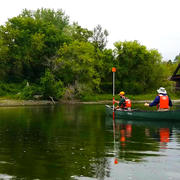
In this issue we introduce our new director, John Bumgarner, presenting his vision for the center. We also feature our hydrologic monitoring program, a recap of the 2020 drought, current work on the Federal Emergency Management Agency flood insurance maps, two geonarratives, and we provide links to our 2020 staff publications and data releases.

A new USGS study has identified factors that contribute to high nitrate in base flow in streams flowing into Chesapeake Bay. Land use, organic carbon in soils, and geology were among the most important factors affecting nitrate in stream base flow, based on data collected at 156 stream sites.

List of data releases and publications from the New England Water Science Center released in 2020.

The Hydrologic Monitoring Program (HMP) conducts hydrologic surveillance and investigation in all six New England States.
A total of $125,000 will fund new research and preserve important data across the Mountain State
A total of $118,479 will fund new research and preserve important data across the Pine Tree State
A total of $100,000 will fund new research and preserve important data across the Keystone State

The New England Water Science Center has collected, reviewed, and aggregated water-withdrawal data in each of the six New England States every 5 years since 1950. The most recent water-use compilation was completed in 2015, and its summary is presented in this geonarrative.
The scarcity or overabundance of water presents some of the most dangerous, damaging and costly threats to human life, ecosystems and property in the form of drought, floods and debris flows.










